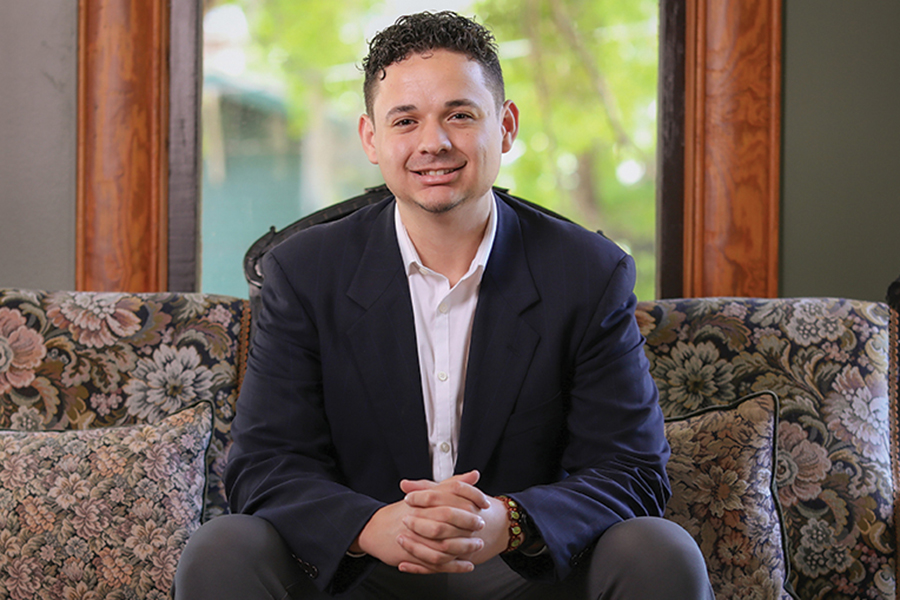Safeguarding Sites
Public history graduate student Alessio Luna works to preserve North Florida landmarks, protect communities’ history

While en route to Florida State’s Tallahassee campus, Alessio Luna makes a quick stop in a small Panhandle town for fuel and a snack. He also scopes out the surrounding buildings, wondering about the people and the lives lived within their walls.
Most folks wouldn’t spend a road-trip pitstop exploring any town’s Main Street, but Luna, a master’s student in the FSU Department of History’s Historical Administration and Public History program, sees lesser-known historical structures like banks, courthouses, and schoolhouses as valuable North Florida cultural heritage sites.
Luna, who was born and raised in Miami, focuses on identifying key sites, researching their connection to the community’s history, and preventing destruction by developers. He hopes to establish sustainable landmarks that serve as visitor destinations, providing an economic benefit to counties in need.
“We’re at a crossroads in preservation where development and cost of living are on the rise, and factors of greed and opportunity have blinded many,” he said. “As Floridians passionate about protecting our cultural heritage, we must understand these risks.”
Luna interns with the Florida Trust for Historic Preservation, a statewide nonprofit with a mission to promote preservation and sharing of the state’s diverse architectural, historical and archaeological heritage. The Trust is located in Tallahassee within the Hayes-Hood House, which was built in 1910 and functions as both an office and landmark.
There, Luna works with the Eleven to Save program — an annual list of Florida’s 11 most endangered sites — aligning prior years’ work to build connections among protected locations and strengthen arguments for future preservations. Another part of Luna’s work involves helping to manage the Trust’s easement program, which allows for perpetual preservation of significant historic structures through donating a portion of the building to the nonprofit.
“The work around easements involves much research, meaning Alessio is part investigative reporter,” said Melissa Wyllie, Florida Trust CEO and president. “He’s unstoppable, very thorough in research, and a wonderful addition to our team.”
As the first intern in the Eleven to Save program’s 16-year history, Luna promotes adaptive reuse, which is maintaining historic buildings’ exteriors while replanning interiors to accommodate modern needs, such as housing a CVS Pharmacy within a historic bank. This work, commonplace in areas with strict preservation laws, balances preservation and economic development needs.
For his capstone graduate project, Luna is establishing a Florida landmark designation for the Old Gulf County Courthouse located in Wewahitchka, a small town 30 miles east of Panama City. He updated the courthouse’s description on the Florida Master Site File, the state’s online inventory of cultural and historical resources, from a few blurred photographs and an incorrect and incomplete description and history to a detailed and accurate submission, and he's gathered a bulging file of primary evidence demonstrating the building’s impact on Gulf County and its residents.
“I feel a sense of obligation. History is being created daily, and without protection, it will be erased. From a cherished community site to a national memorial, all of it is history. I look forward to uncovering what can be done to preserve it.”
— Alessio Luna
“Alessio works closely with Florida communities,” said Kathleen Powers Conti, an assistant professor of history who has mentored Luna throughout his time at FSU. “He also advocates for pro-preservation legislation and funding and met with legislators across the state during this year’s session.”
While earning his bachelor’s degree in communications at Florida Gulf Coast University, Luna volunteered with the Collier County Museums where he was introduced to digital antiquity, the practice of curating physical artifacts online. Later, he worked with the Digital Archaeological Record, a tool for storing and searching digitized artifacts, allowing for mass accessibility while protecting the items from damage or loss.
As a preservationist working with façade easements — site exteriors — digital records are invaluable, he explained. They can, for example, include 3D models of buildings within flood or fire zones or within smaller towns lacking preservation funds, so even if a physical structure is destroyed, historians and communities can still reference a site’s contribution to Florida heritage.
“As public historians, we’re always thinking about how our actions will affect the next generation,” Luna said. “Promoting digital antiquity protects fragile history and serves future generations of historians.”
With a love for his home state and its history, Luna hopes to drive change in public and government opinion regarding conservation’s importance. He plans to work with statewide and regional preservation organizations following his graduation in 2025.
“Standing in historic properties, I feel a sense of obligation,” Luna said. “History is being created daily, and without protection, it will be erased. From a cherished community site to a national memorial, all of it is history. I look forward to uncovering what can be done to preserve it.”

